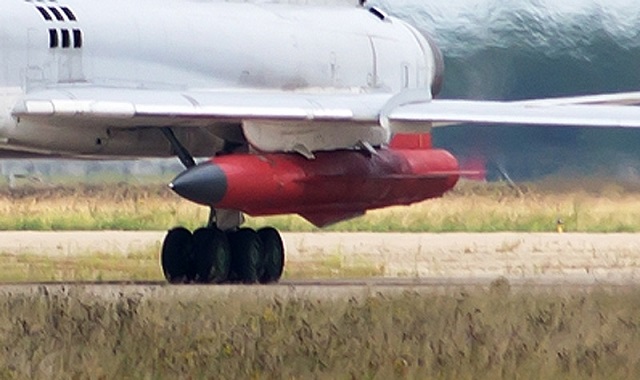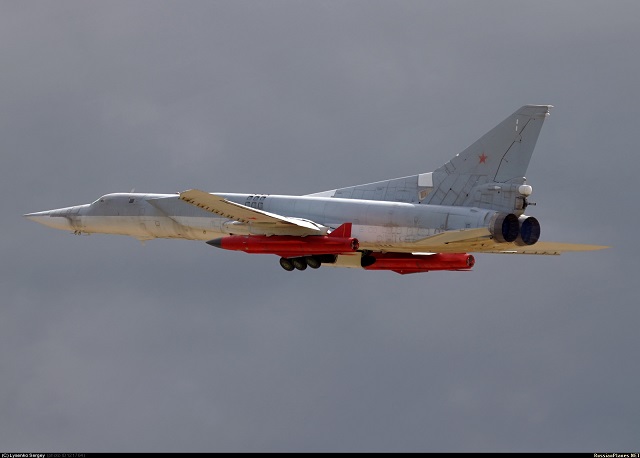 Close up view of a Kh-32 dummy missile used during tests aboard a Tu-22M3 in July 2013. Picture by Mikhail Polyakov, http://russianplanes.net |
|||
A
source in Russia’s defense industry has confirmed that the Kh-32
missile’s tests were in final stages, and the weapon itself was
at a very high degree of product availability. The Tactical Missiles Corporation,
Raduga’s parent company, has confirmed that the work on the latest
product is under way, but declined to comment on its progress. According to expert Dmitry Kornev, the advanced cruise missile is designed, in the first place, to deal with enemy ships, radars and so-called radio-contrast targets, e.g. bridges, military bases, electric power plants, etc. After the launch by the Tu-22M3, the missile climbs to 40 km, transitions to level flight, approaches the target and dives toward it. Since the Kh-32 has an inertial navigation system and a radar homing head, its accuracy is independent of GPS/GLONASS navigation satellite updates. Presumably, the weapon has a range of 1,000 km and a speed of 5,000 km/h at the least. The combination of speed and flight path makes it virtually invulnerable to enemy surface-to-air missiles and fighter jets. The new cruise missile is a derivative of the Kh-22 family that has been until recently the mainstay of the weapons suites of both the Tu-22M3 supersonic bombers and the older, now-decommissioned Tu-22M2s. |
|||
 Tu-22M3 number 9804 in flight test with 2x Kh-32 in 2013. Designed to break the enemy's air defense and attack carrier battle groups, Russian media reported that the missiles are able to exchange information after launch via datalink and able to withstand 20mm gun fire as well as small surface to air missiles. Photo by Sergei Lysenko, http://russianplanes.net/id121764 |
|||
The Soviet Navy alone had more than 10 Tu-22M3 regiments organized with
five air divisions. The Soviet Air Force had about the same number of
the bombers. Each regiment comprised 20 Tu-22Ms capable of hauling 40
or 60 Kh-22 missiles depending on the range to the target, according to
Russian Navy historian Dmitry Boltenkov. A primary target for the Tu-22M3s
were US Navy aircraft carrier strike groups. A salvo by a Tu-22M3 regiment
would guarantee the elimination of the carrier itself and all of her escorts
- cruisers, destroyers and guided missile frigates. The Kh-32’s development was kicked off in the early 1990s and its early launches are believed to have taken place in the mid-2000s. In summer 2013, pictures of a Tu-22M3 carrying Kh-32 mockups on experimental sorties were published. They were taken at the airfield of the Gromov Flight Research Institute in the town of Zhukovsky, according to the Izvestia daily. © Copyright 2016 TASS. All rights reserved. This material may not be published, broadcast, rewritten or redistributed. |
|||
Next Gen Kh-32 ant-ship cruise missile tests drawing to a close in Russia
- Posted On










